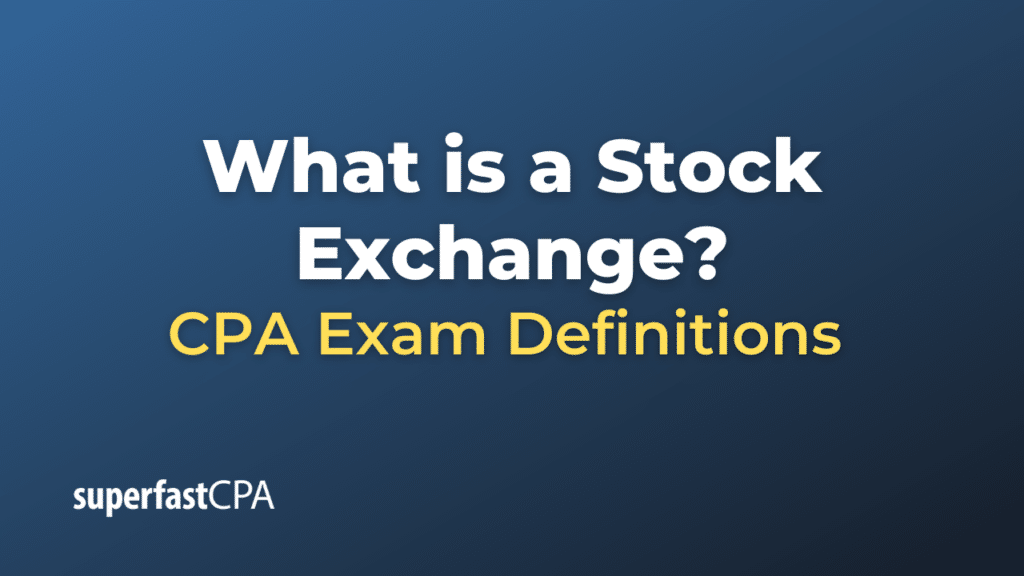Stock Exchange
A stock exchange is a regulated marketplace where financial instruments, especially shares of publicly-held companies, are bought and sold. Stock exchanges play a crucial role in the capital markets by providing a platform for companies to raise capital from a wide pool of investors. In return, investors get an opportunity to own a portion of the company and potentially share in its profits and growth.
Key features and functions of a stock exchange include:
- Liquidity : Stock exchanges provide liquidity, making it easier for investors to buy and sell securities. This liquidity reduces the risk of holding securities by ensuring that securities can be easily converted into cash.
- Price Discovery: Through the interaction of buyers and sellers, stock exchanges help in determining the price of traded securities, which reflects their current market value based on available information.
- Regulation and Oversight: Recognized stock exchanges operate under strict regulations to protect investors. This includes ensuring that listed companies meet specific financial, governance, and disclosure standards.
- Transparency: Companies listed on stock exchanges are required to disclose significant financial and operational information, ensuring transparency and aiding investors in making informed decisions.
- Capital Raising: Companies can raise capital for expansion or other projects by issuing shares to the public through a stock exchange.
- Economic Indicator: The overall performance of a stock exchange, often represented by a market index, can serve as an indicator of the health of a country’s economy and investor sentiment.
Some of the world’s major stock exchanges include:
- New York Stock Exchange (NYSE): Located in the U.S., it’s one of the world’s largest stock exchanges by market capitalization.
- Nasdaq: Also in the U.S., it’s known for its electronic trading platform and its concentration of technology companies.
- Tokyo Stock Exchange (TSE): Japan’s premier stock exchange.
- London Stock Exchange (LSE): One of the world’s oldest exchanges, located in the UK.
- Shanghai Stock Exchange (SSE) and Shenzhen Stock Exchange: Major exchanges in China.
- Hong Kong Stock Exchange (HKEX): A significant global exchange located in Hong Kong.
These exchanges, along with others globally, facilitate the efficient transfer of capital between investors and those in need of capital, driving economic growth and development.
Example of a Stock Exchange
Let’s use a hypothetical example to illustrate how a stock exchange works:
Background:
Imagine a tech startup named “FutureTech Innovations.” The company began a few years ago and has developed a revolutionary solar-powered gadget that’s gained significant market attention. The founders initially funded the company using their savings and some funds from angel investors. But now, to scale production and expand globally, FutureTech needs a substantial amount of capital.
Going Public:
To raise this capital, FutureTech’s leadership decides to “go public” and list its shares on a stock exchange. By doing so, they can sell a portion of the company to the public in what’s known as an Initial Public Offering (IPO).
Steps Involved:
- Engage Underwriters: FutureTech partners with an investment bank, which acts as an underwriter. The bank helps FutureTech determine the IPO price, the number of shares to be issued, and assists in the marketing of the shares.
- Regulatory Approval: FutureTech must prepare a prospectus detailing its finances, business model, and risks. This document is submitted to the regulatory authority overseeing the stock exchange. In the U.S., this would be the Securities and Exchange Commission (SEC).
- IPO Launch: Once approved, FutureTech’s shares are made available to the public at the IPO price. Investors can now purchase shares, with the money raised going to FutureTech.
- Regular Trading: After the IPO, FutureTech’s shares are listed on the stock exchange, where they can be bought and sold like any other publicly traded company. The stock price will fluctuate based on supply and demand dynamics, company performance, market news, and other factors.
Investor Perspective:
Imagine Sarah, an individual investor. She believes in the potential of FutureTech and decides to invest:
- Buying Shares: On the IPO day, Sarah buys 100 shares of FutureTech at the IPO price of $20 each, spending $2,000.
- Monitoring & Selling: Over the next year, due to strong sales and positive news, FutureTech’s stock price rises to $30. Sarah decides to sell her shares. She sells her 100 shares at $30 each, receiving $3,000.
- Profit: Sarah’s profit from this transaction would be $1,000 (excluding any fees or taxes).
Through the stock exchange, FutureTech successfully raised capital, and investors like Sarah had the opportunity to invest in a company they believe in and potentially earn a return on their investment. This example demonstrates the primary functions of a stock exchange: facilitating capital raising for companies and investment opportunities for individuals.













